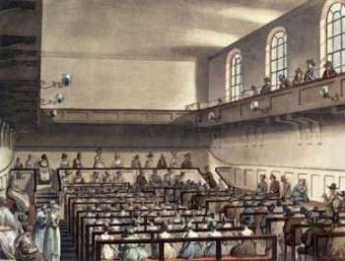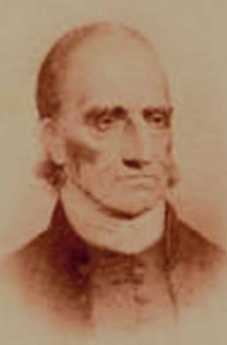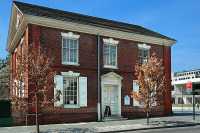Related Topics
Religious Philadelphia
William Penn wanted a colony with religious freedom. A considerable number, if not the majority, of American religious denominations were founded in this city. The main misconception about religious Philadelphia is that it is Quaker-dominated. But the broader misconception is that it is not Quaker-dominated.
Quakers: The Society of Friends
According to an old Quaker joke, the Holy Trinity consists of the fatherhood of God, the brotherhood of man, and the neighborhood of Philadelphia.
Quaker Doctrine and Schism

|
| Society of Friends |
The Society of Friends had never promulgated articles of religion to be subscribed, or a catechism to be taught." In this curious manner, a lack of doctrine has become the doctrine. Still more unexpectedly, a religion dedicated to peace and non-violence has mostly defined itself by resisting some proposals so violently that schism was the result. The central propositions can now be best deduced by observing the reasons why dissenters departed the Society, or why agitators were invited to depart. It can be questioned whether the early Quakers who shaped the Society really intended for non-members to define it. And so, eligibility for membership became the place where the doctrine was found, formed and enforced.
In 1691 the first serious rebellion from non-doctrine came from George Keith, who may well have had exactly this issue in mind. Aside from Thomas Lloyd the Deputy-Governor, Keith was the most learned and educated man in the colony, with a large following of admirers. It seems unfair to accuse Lloyd of jealousy, but he was probably Keith's only intellectual equal at the time, and was burdened with the responsibility of governing the colony with full respect for the interests of the then-absent proprietor, William Penn. When Keith raised the concern that unwritten Quaker principles could not be confidently explained or disputed, Lloyd remained silent for a time. However, when antagonism to what Keith was saying reached the point of prosecution and expulsion from the Society of Friends, Lloyd must certainly have been in the background. Keith eventually became an Anglican priest, taking a number of Quakers with him. It must be said on behalf of George Keith that he made the first written protest against negro slavery, sixty years earlier than the more famous actions of the Germantown meeting. His eventual spiritual direction is surely evidence that he longed for closer adherence to Biblical Christian teachings or even rituals. Lloyd, on the other hand, is thought to trace descent from the early Princes of Wales, and could well have over-reacted to ideas which might destabilize power.
Keith may have been more persuasive than he seemed, however. By 1827 the pendulum appears to have swung against excessive thee-and-thou doctrine, however unwritten it may have been. Having experienced one schism from those who wanted more doctrine,

|
| Elias Hicks |
Elias Hicks then split the Society with a return to mysticism, seeking less rigidity and doctrine where Keith had once demanded more of it. After the 1827 separation, Quakers were to remain divided into two religions, the Hicksite and the Orthodox, for a century until Rufus Jones led the two factions to reunite. The banners they waved were "the inner Christ" and the "outward Christ" and for some, the central issue was Biblical doctrine and ritual. For others, it was a matter of balance between obedience and individualism. At present, the Quaker doctrine remains unwritten, although a book called "Faith and Practice" explains what has been customary. Quakers are now a long way from wearing black hats and "plain" speech, and in fact, do come fairly close to what Hicks was striving for. In many ways, the doctrine of "the light within" is held to be sufficient to define the mystical core of Quaker belief, from which everything else may be derived, particularly when it is linked to another central belief, that "there is That of God, in every man." William Penn's famous tolerance of religious freedom, for example, can be viewed as a comfortable belief that if serious people of all religions examine the issues deeply, it can be expected they will all eventually reach about the same conclusions.
The simple formula of "not enough ritual" versus "too much ritual" arriving at its present state of "just enough ritual" must be qualified by two other schisms, however.
When the Revolutionary War came to Pennsylvania, a certain group of Quakers exemplified by Betsy Ross, Timothy Matlack and Nathaniel Greene but led by Samuel Wetherill, wanted to fight for Liberty enough to split off their own church, The Free Quakers.

|
| The Free Quakers. |
Although the surface issue was opposition to the war for any reason, in 1781 the Revolutionary War was mostly over, at least in the northern colonies. Several prominent Free Quakers had been read out of the meeting before the Revolution for reasons unrelated to it, and many other joiners to the Free Quakers had apparently not previously been practicing Quakers at all. The larger underlying political upheaval was the Quaker withdrawal from government twenty years earlier. This too was explained as a refusal to fight wars for any reason, but it can also be seen as the dilemma of all religious states, who cannot fairly govern a non-believing minority without either persecuting them or allowing them to usurp. Buying the land from underneath the Indians was one thing; living peacefully alongside the unruly Scotch-Irish of Western Pennsylvania proved to be quite another. The splitting off of a separate sect of Quakers with a different doctrine must be seen in the context of an even larger migration out of Quakerism entirely, into the Anglican, later Episcopal, church, which was favored by the wealthier segment of colonial Quakers, encouraged by some doctrinal adjustments by Bishop White. Even that synopsis fails to capture what was happening. In 1705 the Pennsylvania Assembly, composed entirely of Quakers, signed a petition to King William III ("William of Orange") which had the effect of a bargained compromise: in return for permitting affirmations instead of oaths, the King agreed to extend liberty of conscience under the English Act of Toleration of 1696 to those who subscribed to what would today be called the Apostles Creed. Through the hazy lens of intervening history, it is difficult to see why this was a useful compromise, except for what is implicit. As long as Pennsylvania was firmly Tory, the English king would do any necessary fighting on the frontier, and the pacifist Quakers could continue to control the government. Seventy years later, in 1776, that no longer seemed a workable arrangement, and in fact, the Quakers had withdrawn from the government in 1756.
After the upheavals of adjusting to a new system of government, the nation settled down to enjoy what was the main reward of Independence: vast stretches of unoccupied fertile land to the West. A selectively agrarian segment of Quaker society migrated to Ohio, Indiana, and Iowa. These scattered pioneers did not have Penn, Lloyd, and Logan to guide them, and felt a much greater need for pastoral guidance. In time, mid-western and western Quakers evolved into formal churches with ministers, and colleges to teach the ministers, while the eastern seaboard Quakers remained seated in silent worship, without ministers or music, in "unprogrammed meetings". And so, back to where we started, searching for the proper balance between mysticism and ritual. But primarily among those Quakers who remained unmoved, spiritually and physically, by the fragmentation of what had once essentially been an established religion.
Originally published: Wednesday, June 21, 2006; most-recently modified: Monday, June 03, 2019
| Posted by: John Shaw | May 18, 2010 6:45 PM |